Posts Tagged ‘Ice dam heat tape’
Friday, February 3rd, 2017
The Relationship Between Ice Dams and Icicles
Do Icicles Mean Ice Dams?
You may notice that the home shown below has some icicles (sarcasm intended). Obviously, when something like this occurs, it is quite likely that you have ice dams as well as a giant insurance claim from the subsequent water damage it has caused. The fact is, the vast majority of the ice dam steaming projects we complete are not on homes with monster icicles. When we arrive we often see quite modest icicles from the ground. The relationship between icicles and ice dams is not difficult to understand when you study the problem for awhile. This Case Study digs into the topic of icicles and ice dam life cycles.
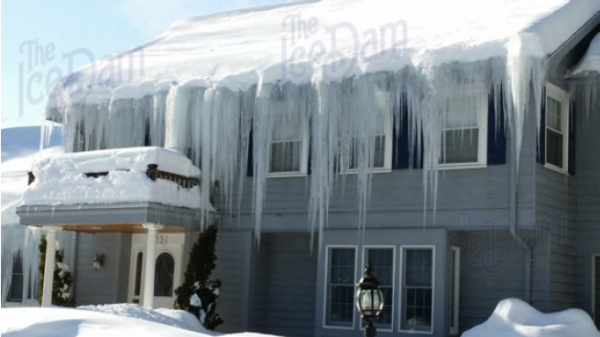
Do icicles mean ice dams? The short answer is NO. While icicles on the edge of the roof are often a precursor to ice dams, they are not always present when ice dams begin to cause leaks through a roof system. Ice dams and icicles are part of the same accumulation but they are not the same thing by any means. This brings us to the normal life cycle of an ice dam.
The characteristics of ice dams change over time. The typical lifespan of an ice dam rangers from a few days to a few weeks. During that time it may get thicker or thinner, icicles may appear and disappear on its’ leading edge, and it may be almost completely hidden under snow or partially or completely exposed. For this reason, there is a big different between a young ice dam and an old ice dam in terms of the presence of icicles. Very young ice dams often have visible icicles on their leading edge. Over the following days most ice dams tend to grow more in depth than thickness, meaning the ice migrates higher up on the roof plane (refer to Case Study #06 for more information). Icicles on more mature ice dams tend to melt away from the affects of direct sunlight or warmer outdoor temperatures. However, while the telltale icicles may be missing, the mass of the ice dam is left behind, frequently hidden under a blanket of snow.

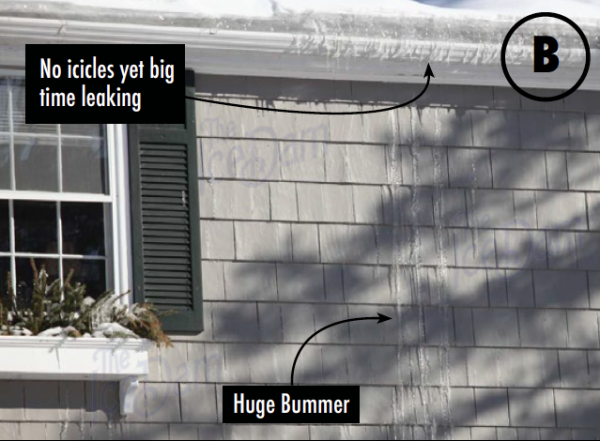
The photos above (A) and (B) demonstrate this phenomenon on two St. Louis Park homes. Virtually no traditional signs of an ice dam and yet you see water leaking down the exterior wall, through the siding and in the wall cavity itself. Bad news.
Case Study #16 examines the important topic of ice migration, from icicles to the interior of your home.
To read more Case Studies click here.
Tags: about ice dams, best ice dam removal in minneapolis, best rated ice dam removal contractor, edina ice dam removal, highest rated ice dam removal company in minneapolis, how do I know I have ice dams, how to file an insurance claim for an ice dam, ice and snow removal, ice dam expert, ice dam heat cable, Ice dam heat tape, ice dam prevention, Ice dam removal, ice dam removal jerks, minneapolis ice dam removal, twin cities ice dam remover, wayzata ice dam removal
Posted in Ice Dam Heat Tape, Ice Dam Prevention, Ice Dam Removal, Ice Dams, Misc., Ice Dams: General Info, Water Damage | Comments Off on Icicles and Ice Dams
Thursday, December 22nd, 2016

Roof deicing cable
HeatTapePro is a premium brand of commercial-grade, self-regulating heat cable. We are strategic partners with the Radiant Solutions Company, the direct manufacture of HeatTapePro and all related installation accessories.
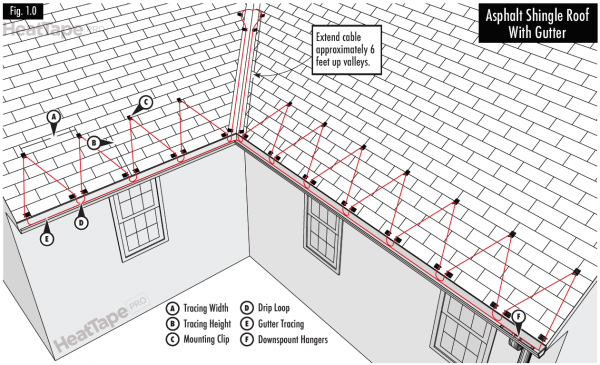
Ice dam roof deicing cable installation information
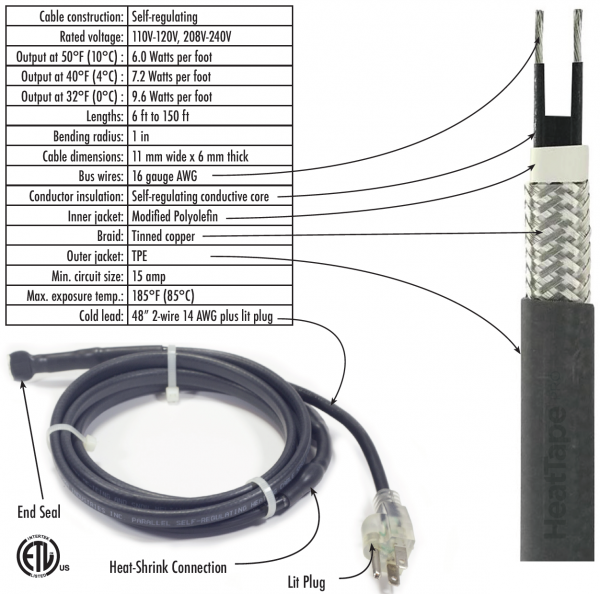
HeatTapePro self-regulating heat cable
HeatTapePro self-regulating heat cables are designed to be used for a variety of roof de-icing, gutter de-icing and pipe freeze applications. Self-regulating heat cable automatically calls for more energy when ambient outdoor temperatures are lower and conversely, less energy when outdoor temperatures are higher. HeatTapePro is pre-terminated in our factory for your safety and convenience. No field modifications will be necessary to the cable to use it for the described purposes.
You can purchase HeatTapePro through our store here or at The Heat Cable Store, , Ebay or Amazon.
Tags: best ice dam heat cable, best rated ice dam heat tape, gutter deicing wire, Heat cable, heat tape, heater cable, heater coils, highest quality heat cable, Ice dam heat tape, ice dam heat wires, minneapolis ice dam removal
Posted in ice dam coils, Ice dam heat cable, Ice Dam Heat Tape, Ice Dam Prevention, Ice Dam Removal, Ice Dam Removal with Steam | Comments Off on Heat Tape Pro Self-Regulating Heat Cable
Wednesday, December 21st, 2016
It’s official. The 2016 ice dam season has begun. We had a number of crews out today removing ice dams from St. Louis Park, Minneapolis, Edina, Minnetonka and St. Paul. We have more ice dam steamers than anyone in the country and yet it always feels like a bit of a scramble the first day. Men, supplies and equipment all being organized and deployed from our headquarters in Hopkins. Our warehouse looked like a war zone today. Hoses, anti-freeze and kerosene containers, steamers, shovels, all scattered around as we assembled the trucks for duty. As hectic as operations are the first day of each season, our clients see none of it. I liken the whole thing to a duck moving across a pond. From above the duck glides seemingly effortlessly but under the water his legs are moving like crazy. After this many years in business, I know this is how most businesses happen.
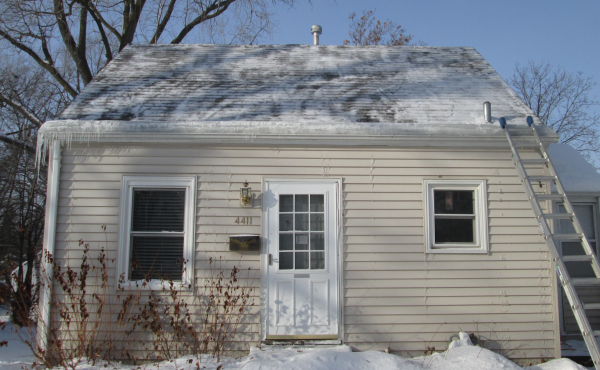
Before and after of ice dam removal project in Minneapolis
Here’s something cool from today. Our guys are all professional roofers which means they understand exterior envelopes and construction assemblies. Today one of our guys found a massive install error on a low-pitch rolled asphalt roof in Minneapolis. The client had no idea. The original roof installer failed to use adhesive between the roofing plies! That’s a major no-no. They also had all of the penetrations negatively lapped (sequenced into the asphalt improperly). Good catch Paul!
The Ice Dam Company is in fact the only company in the country with the in-house chops to diagnose and address problems with insulation, ventilation, roofing, sheet metal and other exterior envelope components. We also install miles of self-regulating heat cable each year on homes where architectural solutions are not appropriate or feasible. Most ice dam removal guys just use their pressure washers to squirt ice off the roof and that’s the end of it. For us, ice dam removal projects are often just the beginning of a longterm relationship with our clients. The Ice Dam Company is a division of Kuhl’s Contracting, the third largest residential construction and remodeling company in Minnesota. There is a huge amount of cross-pollenization between the organizations. Each benefits from the resources and talents of the other. It’s fun to witness.
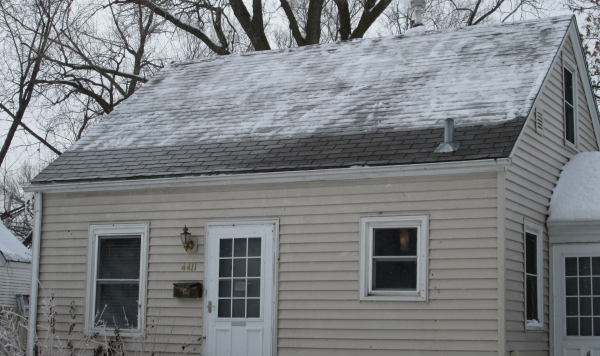
Ice dam removal project before and after photos from Minneapolis project 12-21-16
Tags: best ice dam removal business, best ice dam removal company, ice dam heat cable installer, Ice dam heat tape, ice dam prevention experts, Ice dam removal, ice dam removal and prevention in Minnesota, ice dam removal minneapolis, roofing company minneapolis
Posted in Ice Dam Heat Tape, Ice Dam Prevention, Ice Dam Removal, Ice Dam Removal with Steam, Roof Snow Removal | Comments Off on Minneapolis Ice Dam Removal Before and After
Tuesday, December 20th, 2016
The Relationship Between Sunshine and Ice Dam Formation
Ice dams happen when there is a section of roof that is above freezing (32°) where roof snow melts which then drains to an area that is below freezing, usually the eaves, where it refreezes. The source of this temperature differential is usually the result of interior heat loss, specifically via air leaks and insulation issues. In fact, according to our experience, 95% of our client’s ice dam problems can be mitigated or eliminated altogether through the modification of the thermal characteristics of the home. Still, we see ice dams on certain homes for reasons outside the scope of it’s architectural deficiencies. Homes with what we might call nearly perfect air-sealing, insulation and ventilation still get ice dams. This Case Study describes such a situation.
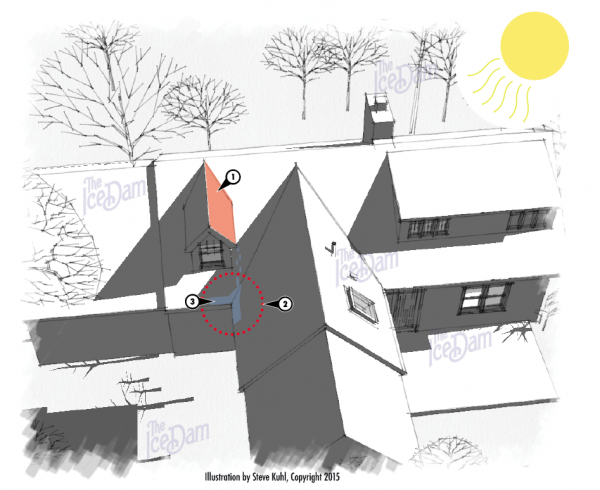
The winter sun hits Minnesota homes (and all homes in this latitude) at a low angle during the winter. The result is that certain roof slopes never see direct sunlight while others get hit quite directly. The above illustration demonstrates an ice dam situation that relates to the heating effects of the sun. Solar radiation warms the roof slope on the dormer (1), the resulting melt water drains to an area of the home (2) that never sees direct sunshine where it refreezes to form an ice dam (3). These are particularly challenging ice dams to prevent. Often times heat tape, also known as heat cables, are the only affordable option.
To read more Case Studies click here.
Tags: about ice dams, best ice dam removal in minneapolis, best rated ice dam removal contractor, edina ice dam removal, edina ice dam steaming, highest rated ice dam removal company in minneapolis, how do I know I have ice dams, ice and snow removal, ice dam expert, ice dam heat cable, Ice dam heat tape, ice dam prevention, ice dam removal jerks, minneapolis ice dam removal, sunshine and ice dams, thermal characteristics and ice dam prevention, thermal imaging and ice dam identification, thermal inspection, twin cities ice dam remover, wayzata ice dam removal
Posted in Ice Dam Prevention, Ice Dams, Misc., Ice Dams: General Info | Comments Off on Sun and Ice Dams: Cause and Effect
Tuesday, December 13th, 2016
Ice Dams on Mansard Roofs Can be a Seriously Big Headache to Remove
Roof Styles Affect Ice Dam Severity
As discussed in Case Study #16, there can be some serious problems if homeowners decide to remove snow from only a portion of the roof plane affected by ice dams. We call it the ‘Double Dam’, which refers to the fact that ice dams can grow much further up the roof when only lower sections of snow are removed (commonly done with roof snow rakes because they can’t reach high enough on the roof).
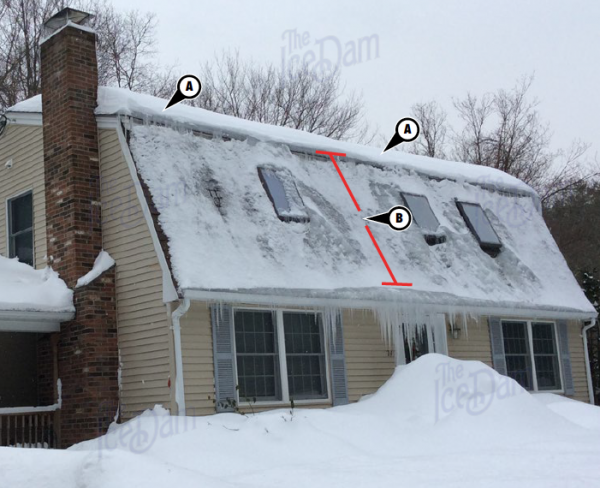
Mansard roofs, such as this one from Edina, Minnesota, can create massive ice dams when the steep pitch (B) is cleared of snow. This is amplified when the slope has directional bias towards the north because the sun will not help melt the ice as it accumulates. In the photo, below, we see two ice dam problems on this Edina mansard roof. The traditional location (A) is exacerbated by the low roof pitch (Case Study #09 explores the relationship between roof pitch, or roof slope, and ice dams). Area B has an ice dam that covers the entire span of the roof slope. This took many hours to remove even with our commercial ice dam steaming equipment.
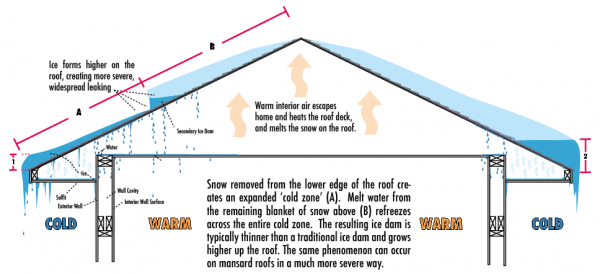
Which Ice Dam Do You Want?
Ice dam #1 is not the one you want. Ice dams like this take hours to remove with steam, which is the most efficient and safe method for removing ice dams. This ice dam is thin but it has grown many feet up the roof. Ice dam #2 is an easier problem to resolve.
To read more Case Studies click here.
Tags: about ice dams, best ice dam removal in minneapolis, best rated ice dam removal contractor, edina ice dam removal, edina ice dam steaming, highest rated ice dam removal company in minneapolis, ice and snow removal, ice dam expert, ice dam heat cable, Ice dam heat tape, ice dam prevention, ice dam removal jerks, identifying an ice dam, is my ice dam bad, mansard roofs and ice dams, relationship between styles of roofs and ice dam formations, removing ice dams with steam, removing massive ice dams, roof ice steaming, roof pitch and ice dam relationship, roof styles and severity of ice dams, twin cities ice dam remover
Posted in Ice Dam Prevention, Ice Dam Removal, Ice Dams, Misc., Ice Dams: General Info | Comments Off on Mansard Roof Ice Dams
Monday, October 5th, 2015
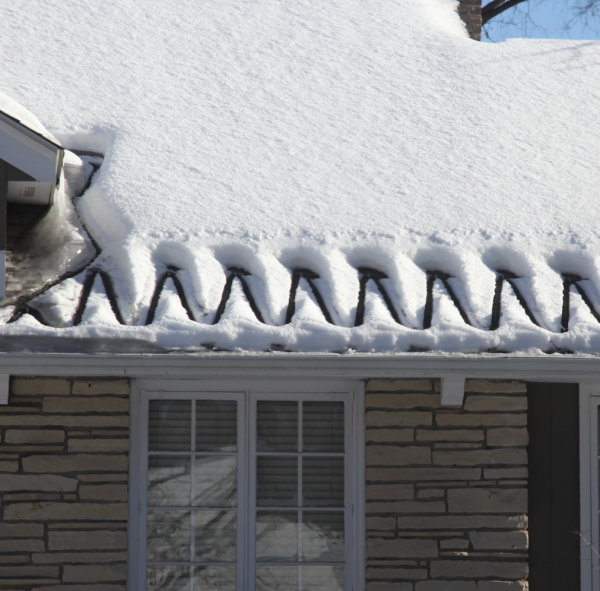
Roof deicing cable for ice dam prevention by the Ice Dam Company
Over the years we have heard people call heat cable many things.
Heat Coils for ice dam prevention:
Heat coils most likely get their name from the fact that the material itself, that is the heat cable, comes in coils and when installed by a hack is sometimes left in coils on the roof. Heat coils for ice dam prevention are of course the same thing as heat cables.
Roof deicing cables for ice dam prevention:
Roof deicing cables get their name from their primary purpose, to deice roofs. The name is a bit of a misnomer, however, because technically, roof deicing cables do not deice the entire roof, or even the majority of it. Ice dam deicing cables only melt channels through a small percentage of the ice dam to enable the passage of water through the ice dam so water is not able to back up behind the ice dam, into the roof material and into the home. Roof deicing cable is commonly used in the control of ice dams. Notice that there is a big distinction between preventing ice dams and controlling ice dams. Roof deicing wire and roof deicing cable is not meant to prevent ice dams so much as it is meant to control the affects of ice dams on roofs.
Gutter heat cables, Gutter heat tape and Gutter deicing cable:
Gutter heat tape also known as gutter heat wire, is used in the same fashion as heat cable, heat tape and roof deicing cable. It’s primary purpose is to melt ice, or more specifically, to prevent the original formation of ice in the gutter. As discussed in the here general section, gutters in fact have nothing to do with either the creation or severity of ice dams. This isn’t to say that using gutter heat tape or gutter heat wire is a bad idea. Having hundreds of pounds of ice form in your gutter system causes problems of its’ own, most notably that the gutters can be ripped off the house by the weight of the ice itself. Gutter heating coils is yet another variation of this category of names.
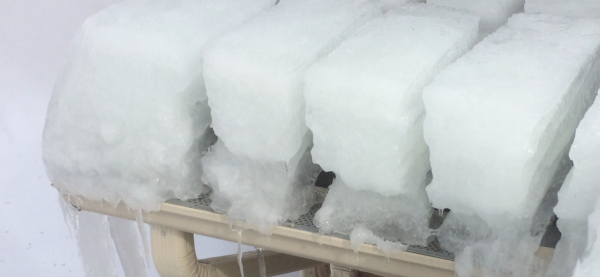
Gutter ice melting cable for ice dam prevention by The Ice Dam Company
Roof Heat Wire and Roof Heat Coils
As with other names, roof heat wire gets its’ name from the perception of its’ intended function. It’s just another way of saying heat cable or heat tape. Roof heat wire is wire on the roof that carries heat with the purpose of controlling ice dams or the damage created by ice formations on a roof.
Tags: gutter deicing wire, gutter heat coils, gutter heat wire, gutter heating cables, Heat cable, heat coils, heat tape for ice dams, heat wire for roof, heating coils for roof, ice dam heat cable, ice dam heat coil, Ice dam heat tape, ice dam prevention coils, ice dam prevention heat cable, roof deicing cable, roof deicing coils, roof deicing tape, roof deicing wire
Posted in Ice Dam Prevention, Ice Dams, Misc. | Comments Off on The Many Names of Ice Dam Heat Cable
Thursday, January 22nd, 2015

Heat tape for ice dams, Electric gutter heating cables for sale
We get asked a lot about the difference between electric heat tape and electric heat cable. The answer is that there is no difference. Both descriptions apply to apply to a category of ice dam prevention cable that is run, usually in a zig-zag pattern, along the affected eaves of a home/building (See install info here). The height, or distance that pattern runs up the roof is determined by the depth of the over hang on the home. The deeper the overhang, the higher the pattern needs to travel.
Not all heat tape is created equal. Think about the difference between a Pinto and an Audi. Sure, they are both cars, but they are pretty different in terms of quality. Honesty alert: Some heat tape is absolute crap. It’s the stuff sold at big box stores under the names Easy Heat and Frost King, to name a few. It costs about 1/3 that of the heavy duty material we install every day. Guess what the difference in labor cost is to install crappy heat cable versus quality heat cable? Zero. It costs zero dollars more to install long-lasting, efficient ice dam heat tape than it does the cheap stuff. We replace thousands of feet of lousy ice dam heat tape every year in the Twin Cities market. Time and time again we see the cheap cables have failed because they have either burned out or have deteriorated due to normal UV exposure.
The moral of the story is please, don’t buy cheap ice dam prevention cable. It won’t last long and it costs far more to operate than quality cable.
Tags: cost for ice dam prevention heat tape, electric gutter heating cable, electric heat cable, electric heat tape for ice dams, ice dam heat cable, ice dam heat cable installer Minneapolis, Ice dam heat tape, ice dam heating cable installation, ice dam prevention tape, professional heat tape advice
Posted in Ice Dam Prevention, Ice Dams, Misc. | Comments Off on Heat Tape for Ice Dams



















